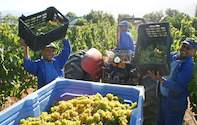After 12 months of caring for a vineyard, it becomes time to harvest. This usually happens from the beginning or mid-January, depending on the cultivar.

A crop forecast is essential to determine the expected volume of grapes per vineyard and the total yield of the farm in order to determine the number of workers needed to bring in the harvest.
It will also help to plan the cost of the harvest and possible income. In addition, the crop forecast helps the winemaker to plan his wine-making and marketing of the wines. The best way to determine a crop forecast is to count the number of grape bunches per vine. Wine grapes are harvested at a predetermined sugar:acid ratio, depending on the end product and wine style required.
The sugar:acid ratio is the amount of sugar and acid in grapes and an indication of ripeness. Other ripeness indicators are: Sugar level, acidity, colour, flavour development and pH
Sugar Level
The sugar level in grapes is measured with a refractometer or ballingmeter and expressed as degree balling (°B) - equal to 1.0 gm/100 gm juice dilution.
Colombar for white wine can be harvested at ± 20°B while red grapes are normally harvested at between 23 and 25°B. Sugar level increases 1°B every four days but can increase by up to 1°B every two days depending on the climate. The sugar level can decrease after rain or irrigation while warm weather increases the tempo of sugar accumulation.
Acidity
Acidity in grapes decreases as sugar levels increase. All wines should have a level of acidity. If not, the wine will be ‘flat' and without character. The two most important wine acids are tartaric acid and malic acid.
Tartaric acid is the main acid in grapes and contributes to taste and the preservation of the wine while malic acid is a naturally occurring acid found in grapes. Malic acid can be digested by malolactic bacteria to form lactic acid and carbon dioxide. Acidity levels are determined in a laboratory and are indicated as gram/litre.
pH
The pH of a wine is an indication of the concentration of the acids in the grapes. The lower the pH, the higher is the wine's acidity. The taste, freshness and complexity (of red wines specifically), are affected negatively by a pH higher than 3,5-3,6.
These could be described as ‘flabby' wines. Wine made from grapes with a high pH do not age well and develop "off" flavours more easily.
Measuring of the pH is extremely important as it can determine the taste, stability and colour of a red wine. Both the acidity and the pH has an important effect on how long a wine can keep.
Colour
Colour development in red wine grapes starts as early as December/January. Colour compounds are formed – just like flavour compounds – in the cell layers just beneath the grape skin. In the majority of red wine cultivars, it is only the skin that is coloured, the flesh stays white.
The colour of a wine comes from the skin and not the juice - the juice in most red grapes is clear (transparent). When the grape juice ferments with the red skins, the colour pigments are transferred to the juice to create a ‘red' wine.
Colour can be determined in a laboratory but can be seen in the vineyard by crushing a berry and rubbing the skin to see if the colour is released. White grape cultivars are yellow or light green in colour.
Flavours
Two groups of flavours are found in wine grapes: natural grape flavours and aromas imparted by the yeast during fermentation. Natural grape flavours are formed by the grape such as the muscat flavour of the Hanepoot and Muscadel grapes.
Flavours formed during the fermentation process cannot be tasted in the grape but is formed when special yeast is added to the juice to ferment the sugar in the grapes.
Source VINPRO Wingerdpraktyke vir Wingerdwerkers